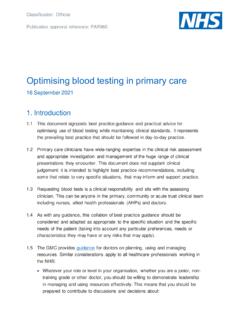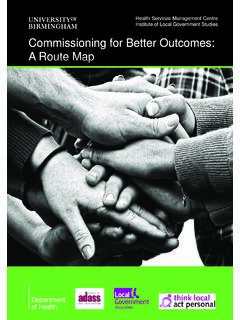Transcription of Integrated Guidance for Management of BBV in HCW - GOV.UK
1 Integrated Guidance on health clearance of healthcare workers and the Management of healthcare workers living with bloodborne viruses (hepatitis B, hepatitis C and HIV) UK Advisory Panel for healthcare Workers living with bloodborne viruses (UKAP) November 2021 health clearance of healthcare workers and the Management of healthcare workers living with bloodborne viruses 2 Foreword In July 2019 UKAP published updated Integrated Guidance that described new recommendations on the monitoring and clearance of HCWs living with hepatitis B infection, and the investigation of situations where a HCW has been diagnosed with a BBV, based on the evidence base and experience from over 20 years of UKAP investigations. Over the past 2 years this Guidance has been embedded into practice and UKAP have received helpful feedback on its implementation. The 2020 update contained changes based on this feedback in order to clarify roles and responsibilities of stakeholders, and the settings in which the Guidance should be applied.
2 This 2021 update contains changes to the recommended monitoring time of HCWs living with hepatitis B. These changes, detailed in section , align with national practice (1 to 2) and other international (3 to 5) guidelines. health clearance of healthcare workers and the Management of healthcare workers living with bloodborne viruses 3 Contents Foreword .. 2 What is new in this document? .. 6 How to use this document .. 7 Chapter 1: Introduction .. 8 Objectives .. 8 Target audience .. 8 Part A: Definition of key terms .. 10 Chapter 2: Exposure prone procedures (EPPs) .. 10 Non-exposure prone procedures .. 11 Exposure prone environments .. 12 Part B: General principles .. 13 Chapter 3: Duties and obligations of HCWs who are, or may be, living with a BBV .. 13 Chapter 4: Roles and responsibilities of organisations .. 15 Occupational health (OH) service .. 15 Employers and commissioning bodies .. 16 Training establishments .. 16 Chapter 5: Confidentiality concerning the healthcare worker living with a BBV.
3 17 Part C: bloodborne virus health clearance .. 18 Chapter 6: health clearance for hepatitis B, hepatitis C and HIV: New HCWs .. 18 Categories of new HCWs .. 19 Standard BBV health checks for all new HCWs .. 21 Additional BBVs health checks (testing for HBV, HCV and HIV) for new HCWs who will perform EPPs, and for existing HCWs who are new to EPPs .. 23 health clearance for HCWs who will perform EPPs: Hepatitis B virus .. 24 health clearance for HCWs who will perform EPPs: Hepatitis C virus .. 25 health clearance for HCWs who will perform EPPs: HIV .. 26 Redeployment and retraining .. 27 Part D: Management of healthcare workers living with bloodborne viruses .. 28 Chapter 7: OH monitoring of HCWs living with BBVs .. 28 health clearance of healthcare workers and the Management of healthcare workers living with bloodborne viruses 4 Monitoring roles and responsibilities .. 28 Monitoring and ongoing clearance for HCWs who will perform EPPs: Hepatitis B .. 32 Monitoring and clearance for HCWs who will perform EPPs: Hepatitis C.
4 35 Monitoring and ongoing clearance for HCWs who will perform EPPs: HIV .. 35 Failure to attend or refusal to test (HBV, HIV and HCV) .. 39 Patient notification exercises (PNEs) .. 39 Management of accidental exposure .. 39 Part E: Risk assessment and investigation of potential exposures .. 40 Chapter 8: The UK Advisory Panel on healthcare Workers living with bloodborne viruses (UKAP) .. 40 The role of UKAP .. 40 When to consult UKAP .. 41 How to consult UKAP .. 41 Chapter 9: Investigation of a HCW diagnosed with BBV, including risk assessment and consideration of patient notification exercise .. 42 Local risk assessment .. 42 Part F: General principles of bloodborne virus infection control .. 45 Part G: Links to Guidance documents and webpages .. 47 Regulatory bodies for statements on professional responsibilities .. 47 UKAP Guidance and documents .. 47 Appendix 1: Laboratory testing arrangements for health clearance and monitoring .. 48 Identified and validated samples (IVS).
5 48 Testing arrangements .. 49 Hepatitis B diagnostic cut-off and changes to designated laboratory status .. 50 Appendix 2: Process of transferring to another accredited specialist in occupational medicine: EPP role .. 52 Appendix 3: Process of transferring to another accredited specialist in occupational medicine: non-EPP role .. 53 Appendix 4: Evolution of policy on the Management of blood-borne viruses in healthcare workers .. 54 HIV .. 54 Hepatitis B .. 55 Hepatitis C .. 57 health clearance of healthcare workers and the Management of healthcare workers living with bloodborne viruses 5 Appendix 5: Previous Guidance documents .. 59 General .. 59 HIV .. 59 Hepatitis B .. 59 Hepatitis C .. 60 References .. 61 About the UK health Security Agency .. 64 health clearance of healthcare workers and the Management of healthcare workers living with bloodborne viruses 6 What is new in this document? Changes in the document from 2019 include: removal of exposure prone procedure (EPP) restrictions, following effective antiviral therapy, and appropriate clearance , for healthcare Workers (HCWs) living with Hepatitis B (HBV) with high pre-treatment HBV DNA levels and or who are e Antigen (HBeAg) positive updated Guidance on the ongoing monitoring and associated reporting to UKAP Occupational health Register (UKAP-OHR) of HCWs living with HBV cleared to perform EPPs updated Guidance on the risk assessment and investigation required following the identification of healthcare workers found to be living with a bloodborne virus (BBV) updated wording on the roles and responsibilities of healthcare workers and their employing organisations including statements about disclosure of BBV status Changes in the document from 2020 include.
6 Responsibilities when transferring monitoring to a new accredited specialist in occupational medicine responsibilities for HCWs moving from an EPP role to a non-EPP role clarifying the responsibility for maintaining records of procedures conducted by HCWs living with HBV and HIV a minor update to Guidance on the roles and responsibilities of Occupational health (OH) Services before clearing a new HCW to perform EPPs revised Guidance on hepatitis C virus (HCV) post-treatment cessation period from 6 months to 3 months clarifying the settings in which health clearance for dialysis procedures is advised confirming that the new specialist is suitably accredited in occupational medicine inclusion of UK crown dependencies and overseas territories Changes in the document from 2021 include: changing the monitoring interval from every 12 months to every 6 months for HCWs living with hepatitis B who have HBV viral load below 200 IU/mL and are not on antiviral treatment changing the monitoring interval from every 3 months to every 6 months for HCWs living with hepatitis B who are on antiviral treatment changing the requirements for resumption of EPPs in those who have ceased hepatitis B treatment from one test at the end of the 12 month EPP restriction period health clearance of healthcare workers and the Management of healthcare workers living with bloodborne viruses 7 to 2 tests 6 months apart, the first being no less than 6 months after ceasing treatment How to use this document The document should be used in electronic format to ensure the most recent Guidance is being followed.
7 health clearance of healthcare workers and the Management of healthcare workers living with bloodborne viruses 8 Chapter 1: Introduction In the UK, the policy on the Management of HCWs living with HBV, HCV and human immunodeficiency virus (HIV) was precautionary and conservative in the first instance (See Appendix 4 for the evolution of UK policy on BBV in HCW). Policies have evolved over time guided by emerging evidence on the risk of HCWs transmitting BBVs to their patients, experience of patient notification exercises (PNEs) and the recommendations of the Expert Advisory Group on AIDS (EAGA), the Advisory Group on Hepatitis (AGH) and the UK Advisory Panel for healthcare Workers living with bloodborne viruses (UKAP), who have regularly reviewed the policies for managing HCWs living with BBVs. Objectives This Integrated Guidance provides updated, evidence-based recommendations that are intended to: reduce the risk of HCW to patient transmission of BBVs reduce the future burden of PNEs retain HCWs in the workforce and reduce adverse social and professional impact on HCWs living with BBVs The Guidance is also intended to provide advice on key operational and service delivery issues that need to be addressed to ensure HCWs living with BBVs who perform EPPs are managed in a manner that safeguards their confidentiality and employment rights.
8 Target audience The Guidance is intended primarily for use by OH services who have the responsibility for dealing with all matters arising from, and relating to, the training and or employment of HCWs living with BBVs in the UK. This Guidance may be applied to OH services in UK crown dependencies and overseas territories. The Guidance should also be brought to the attention of all HCWs working in the UK, in the NHS and other settings including independent contractors such as general dental and medical practitioners and relevant staff; independent midwives; students; locums and agency staff; and health clearance of healthcare workers and the Management of healthcare workers living with bloodborne viruses 9 visiting HCWs, providing a reminder of their responsibility to seek professional advice about the need to be tested if they have been exposed to BBVs. The Guidance is also relevant to NHS organisations who arrange for NHS patients to be treated by non-NHS health establishments in the UK; these organisations should ensure that HCWs who perform EPPs on NHS patients in these settings follow this Guidance .
9 The preparation of the Integrated Guidance has been supported by UKAP and the clinical and public health networks represented by UKAP clearance of healthcare workers and the Management of healthcare workers living with bloodborne viruses 10 Part A: Definition of key terms Chapter 2: Exposure prone procedures (EPPs) Provided appropriate infection prevention and control precautions are adhered to scrupulously at all times, the majority of clinical procedures (including many which are invasive) in the healthcare setting pose no risk of transmission of BBVs from a HCW to a patient and can safely be performed. Those procedures where an opportunity for HCW-to-patient transmission of BBV does exist are described as EPPs, where injury to the HCW could result in the worker s blood contaminating the patient s open tissues. This is described as bleed-back in this Guidance . EPPs include procedures where the worker s gloved hands may be in contact with sharp instruments, needle tips or sharp tissues inside a patient s open body cavity, wound or confined anatomical space where the hands or fingertips may not be completely visible at all times.
10 The definition of EPPs covers a wide range of procedures, in which there may be very different levels of risk of bleed-back. A risk-based categorisation of clinical procedures has been developed, including procedures where there is negligible risk of bleed-back (non-EPP) and 3 categories of EPPs with increasing risk of bleed-back. It should be noted that the majority of HCWs do not perform EPPs. The definitions and examples of categories 1, 2 and 3 are: Category 1 Procedures where the hands and fingertips of the worker are usually visible and outside the body most of the time and the possibility of injury to the worker s gloved hands from sharp instruments and or tissues is slight. This means that the risk of the HCW bleeding into a patient s open tissues should be remote. Examples: local anaesthetic injection in dentistry, removal of haemorrhoids. health clearance of healthcare workers and the Management of healthcare workers living with bloodborne viruses 11 Category 2 Procedures where the fingertips may not be visible at all times but injury to the worker s gloved hands from sharp instruments and or tissues is unlikely.
















